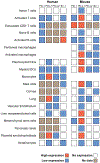PD-1 and its ligands in tolerance and immunity
- PMID: 18173375
- PMCID: PMC10637733
- DOI: 10.1146/annurev.immunol.26.021607.090331
PD-1 and its ligands in tolerance and immunity
Abstract
Programmed death 1 (PD-1) and its ligands, PD-L1 and PD-L2, deliver inhibitory signals that regulate the balance between T cell activation, tolerance, and immunopathology. Immune responses to foreign and self-antigens require specific and balanced responses to clear pathogens and tumors and yet maintain tolerance. Induction and maintenance of T cell tolerance requires PD-1, and its ligand PD-L1 on nonhematopoietic cells can limit effector T cell responses and protect tissues from immune-mediated tissue damage. The PD-1:PD-L pathway also has been usurped by microorganisms and tumors to attenuate antimicrobial or tumor immunity and facilitate chronic infection and tumor survival. The identification of B7-1 as an additional binding partner for PD-L1, together with the discovery of an inhibitory bidirectional interaction between PD-L1 and B7-1, reveals new ways the B7:CD28 family regulates T cell activation and tolerance. In this review, we discuss current understanding of the immunoregulatory functions of PD-1 and its ligands and their therapeutic potential.
Figures




References
-
- Lafferty KJ, Cunningham AJ. 1975. A new analysis of allogeneic interactions. Aust. J. Exp. Biol. Med. Sci 53:27–42 - PubMed
-
- Tivol EA, Borriello F, Schweitzer AN, Lynch WP, Bluestone JA, Sharpe AH. 1995. Loss of CTLA-4 leads to massive lymphoproliferation and fatal multiorgan tissue destruction, revealing a critical negative regulatory role of CTLA-4. Immunity 3:541–47 - PubMed
-
- Waterhouse P, Penninger JM, Timms E, Wakeham A, Shahinian A, et al. 1995. Lymphoproliferative disorders with early lethality in mice deficient in Ctla-4. Science 270:985–88 - PubMed
-
- Nishimura H, Nose M, Hiai H, Minato N, Honjo T. 1999. Development of lupus-like autoimmune diseases by disruption of the PD-1 gene encoding an ITIM motif-carrying immunoreceptor. Immunity 11:141–51 - PubMed
Publication types
MeSH terms
Substances
Grants and funding
LinkOut - more resources
Full Text Sources
Other Literature Sources
Medical
Molecular Biology Databases
Research Materials

